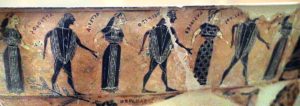Apparently, geranos – crane or chain dance– was performed for the first time by Theseus after rescuing seven youth and seven maidens from the Labyrinth, the maze built by Dedalus to imprison the Minotaur in Cnossos.[1] This complex structure had a single non-branching path which led to the centre, suggesting a continuous movement to the middle and back to the sides, which was accomplished by the hero thanks to Arianna’s gift: a thread that allowed him to move back and forth and thus, enabled him to find the exit after killing the monster. The dance evoked the intricate movements performed by Theseus to escape the labyrinth and may be depicted on the celebrated François Vase, a late 6th century Attic black-figure krater that shows Theseus leading a choral formation on its upper frieze.

Details of the François Vase, Archaeological Museum of Florence
Creative Common Attribution 3.0 Unported license
Chain dances – especially those evoking maze-like movements – can be found in many mystery rites: wanderings of torch-bearing initiates at Eleusis used to represent the wanderings of Demeter in her search for Persephone. The mythic labyrinth in Cnossos has been associated with caves, temples, palaces, and open floors. Dancing consisting of these intricate maze-like movements produced amazement in people and prepared them for mystic realities and a joyous afterlife.[2]
[1] Plutarch, Theseus 21.
[2] Fitton 1973:255-6.
